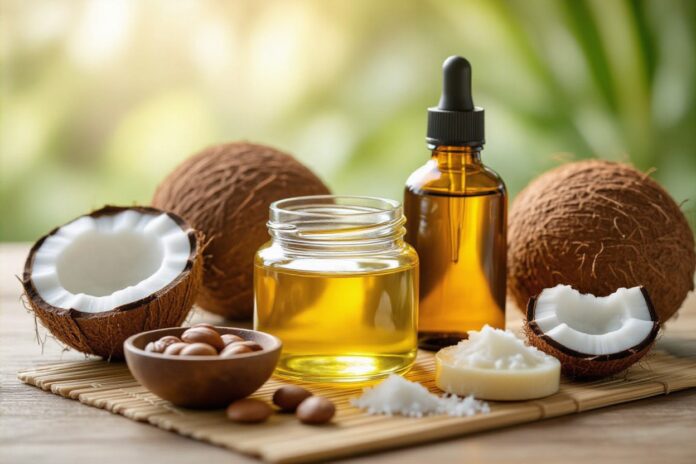Argan-enriched coconut oil gives you a versatile skincare and haircare ally that deeply moisturizes, helps control microbes, and doubles as a gentle, effective makeup remover while argan oil supplies extra hydration and nutrients to restore softness, shine, and resilience to your skin and hair.
This powerful blend helps you deeply moisturize both skin and hair while offering antimicrobial protection; it removes makeup gently and leaves your skin hydrated and nourished thanks to argan oil’s rich fatty acids and vitamin E, making it a versatile, natural addition to your daily care routine.
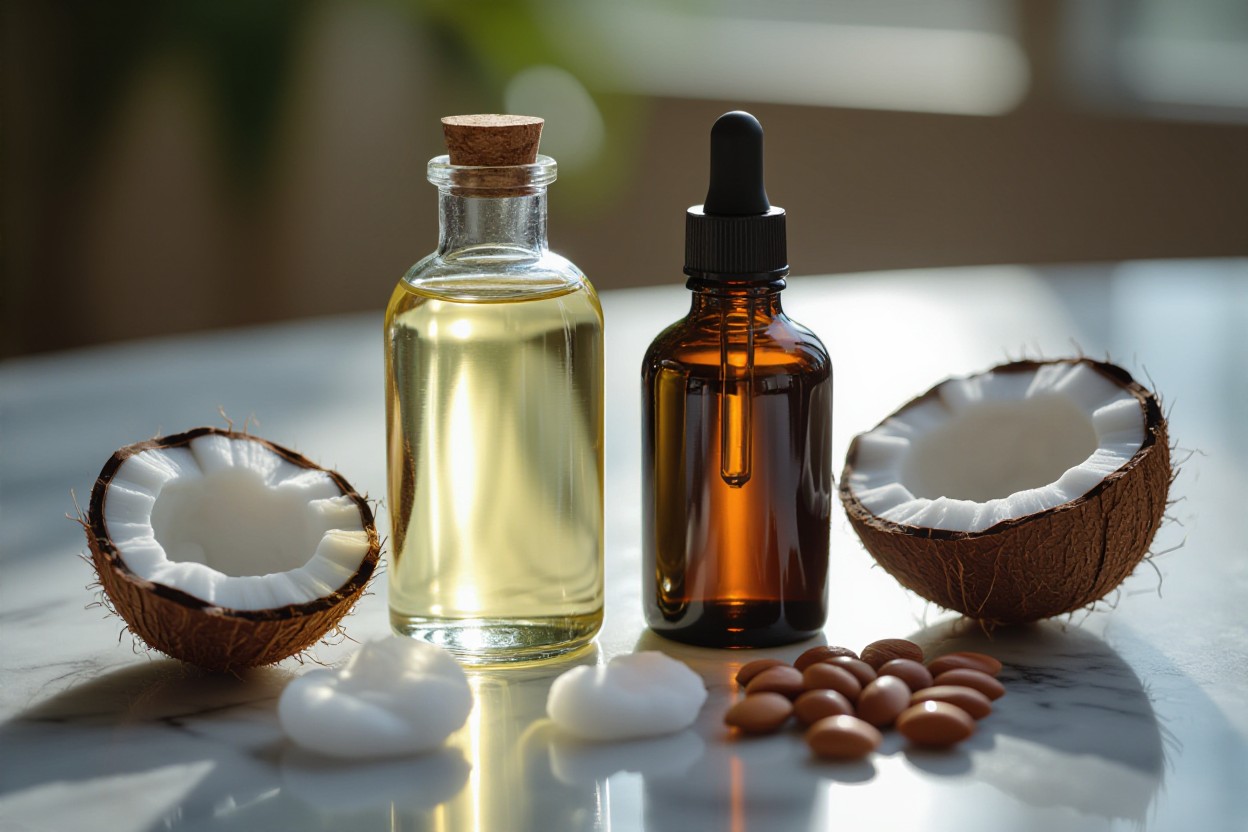
Key Takeaways:
- Locks in moisture for skin and hair, leaving them soft and smooth.
- Antimicrobial properties help reduce bacteria and fungal concerns on skin.
- Effective, gentle makeup remover that dissolves waterproof makeup without harsh chemicals.
- Argan oil adds deep hydration, necessary fatty acids, and vitamin E for nourishment.
- Helps smooth hair cuticle and improves skin barrier, targeting split ends and dry patches.
Key Takeaways:
- Deeply moisturizes skin and hair, helping to reduce dryness and improve softness.
- Contains antimicrobial properties that can support skin hygiene and minor barrier protection.
- Works as an effective, gentle makeup remover that dissolves cosmetics without harsh ingredients.
- Argan oil provides extra hydration and nourishment with necessary fatty acids and vitamin E.
- Versatile, lightweight blend suitable for use on scalp, hair ends, and dry skin patches.
Key Takeaways:
- Deeply moisturizes skin and hair, leaving them softer and smoother.
- Offers antimicrobial properties for mild cleansing support.
- Works as an effective, gentle makeup remover for oil-based products.
- Argan oil adds hydration, nourishment, vitamin E and necessary fatty acids for improved elasticity and shine.
- Versatile: use as a leave-in hair treatment, overnight skin balm, or pre-cleansing oil.
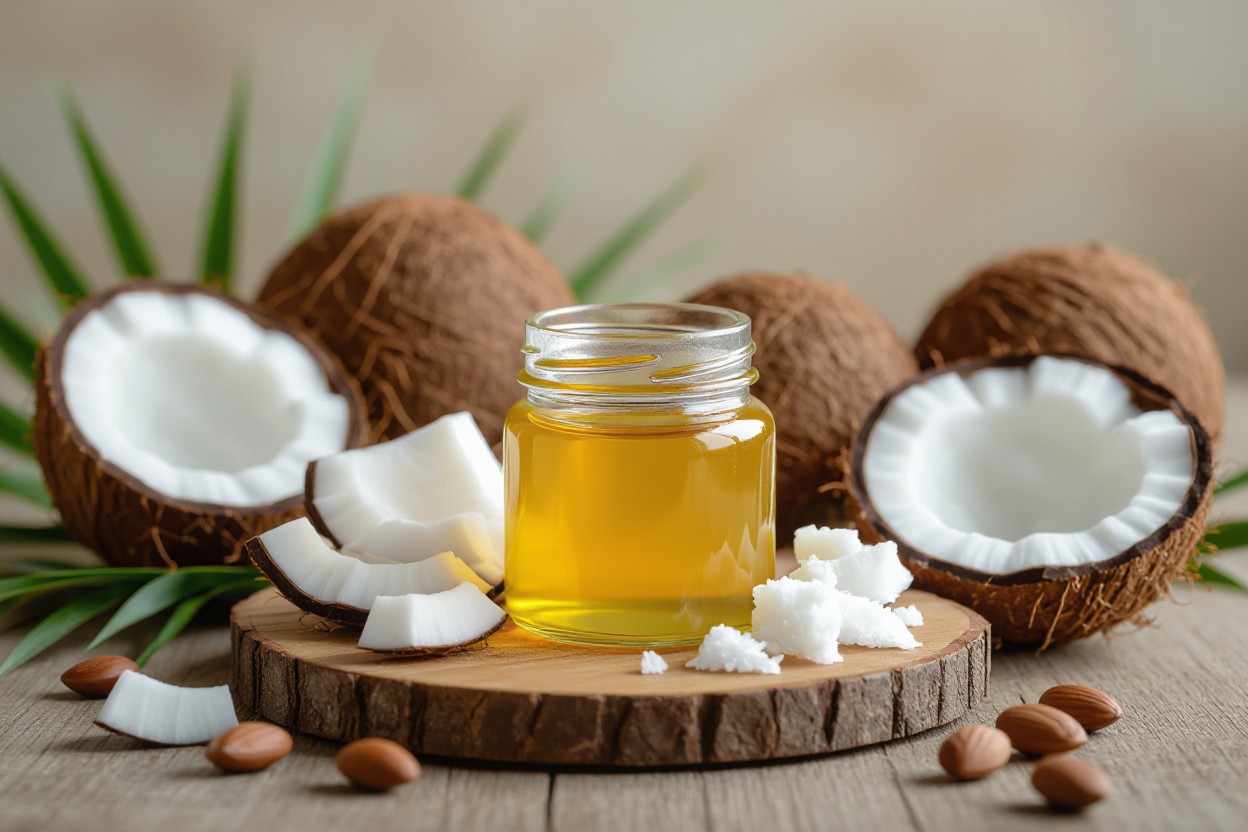
Types of Coconut Oil and Argan Oil
You’ll find oils that range from raw, cold‑pressed options to highly processed, neutral bases; each delivers different levels of lauric acid, vitamin E and scent. Virgin coconut is rich in lauric (≈40–50%) and lends antimicrobial action, while refined offers higher heat stability (~200°C). Pure argan delivers oleic (~43–49%) and linoleic (~29–36%) acids plus 600–900 mg/kg vitamin E. Use specific blends (for example 80% coconut/20% argan) to balance cost, texture and performance.
- Virgin coconut: strong scent, antimicrobial potential, best for topical moisture and makeup removal.
- Refined coconut: neutral scent, higher smoke point, ideal where fragrance-free base is needed.
- Pure argan: high vitamin E and fatty acids for hydration and repair.
- Blended oils: customizable ratios (e.g., 4:1 coconut:argan) for targeted hair or skin treatments.
| Virgin Coconut Oil | Cold‑pressed, high lauric acid (~40–50%), antimicrobial action, solid <24°C; strong coconut aroma. |
| Refined Coconut Oil | Deodorized/bleached, neutral scent, higher smoke point (~200°C), milder topical activity, good cosmetic base. |
| Fractionated Coconut Oil | Liquid at room temp, mainly caprylic/capric triglycerides, lightweight and non‑greasy for leave‑on products. |
| Pure Argan Oil | Cold‑pressed from Moroccan kernels, oleic ~43–49%, linoleic ~29–36%, rich in vitamin E (≈600–900 mg/kg). |
| Blended Oils | Formulations mixing coconut and argan (common: 80/20 or 70/30) to tune scent, absorption and cost. |
Virgin Coconut Oil
You’ll prefer virgin coconut oil when you want antimicrobial benefits plus strong moisturization; cold‑pressed batches often contain 40–50% lauric acid and retain polyphenols that support skin microbiome balance. For makeup removal, apply a nickel‑sized amount, emulsify with water, and rinse—users report softer skin after 1–2 uses. Patch‑test if you are acne‑prone.
Refined Coconut Oil
You may choose refined coconut oil for a scent‑free, stable base that withstands higher heat (around 200°C) and blends unobtrusively into creams and balms; manufacturers deodorize and bleach it to remove flavors while preserving most triglycerides.
Processing reduces phenolic compounds and some antimicrobial activity compared with virgin oil, so you should expect milder topical antiseptic effects; however, refined oil excels in formulations where fragrance masking or a neutral carrier is required, and it’s common in commercial hair serums and heat‑styling products.
Pure Argan Oil
You’ll use pure argan oil when you need concentrated hydration and repair: cold‑pressed oil typically contains about 43–49% oleic and 29–36% linoleic acids plus high vitamin E, which supports barrier function and shine. Apply 1–3 drops to damp hair ends or nightly to face for smoother texture over weeks.
Because pure argan is lightweight yet nutrient‑dense, formulators favor it at 5–20% in serums for elasticity and split‑end reduction; you can also use it neat—users commonly report measurable softness within 2–4 weeks when used consistently.
Blended Oils
You can tailor blends to your goals: for deep hair conditioning try 80% coconut/20% argan warmed and applied as a 20‑minute mask; for facial serums, a 70/30 argan‑to‑fractionated coconut ratio balances absorption and nourishment. Blends reduce cost while preserving targeted benefits.
Mixing also lets you control texture and scent—fractionated coconut thins the blend, refined coconut mutes aroma, and small argan percentages (10–30%) deliver vitamin E and unsaturated fatty acids without greasiness; test ratios on your hair or a small skin area to find the sweet spot.
Any selection should match your skin type, intended use and budget, so patch‑test and evaluate results over 2–4 weeks.
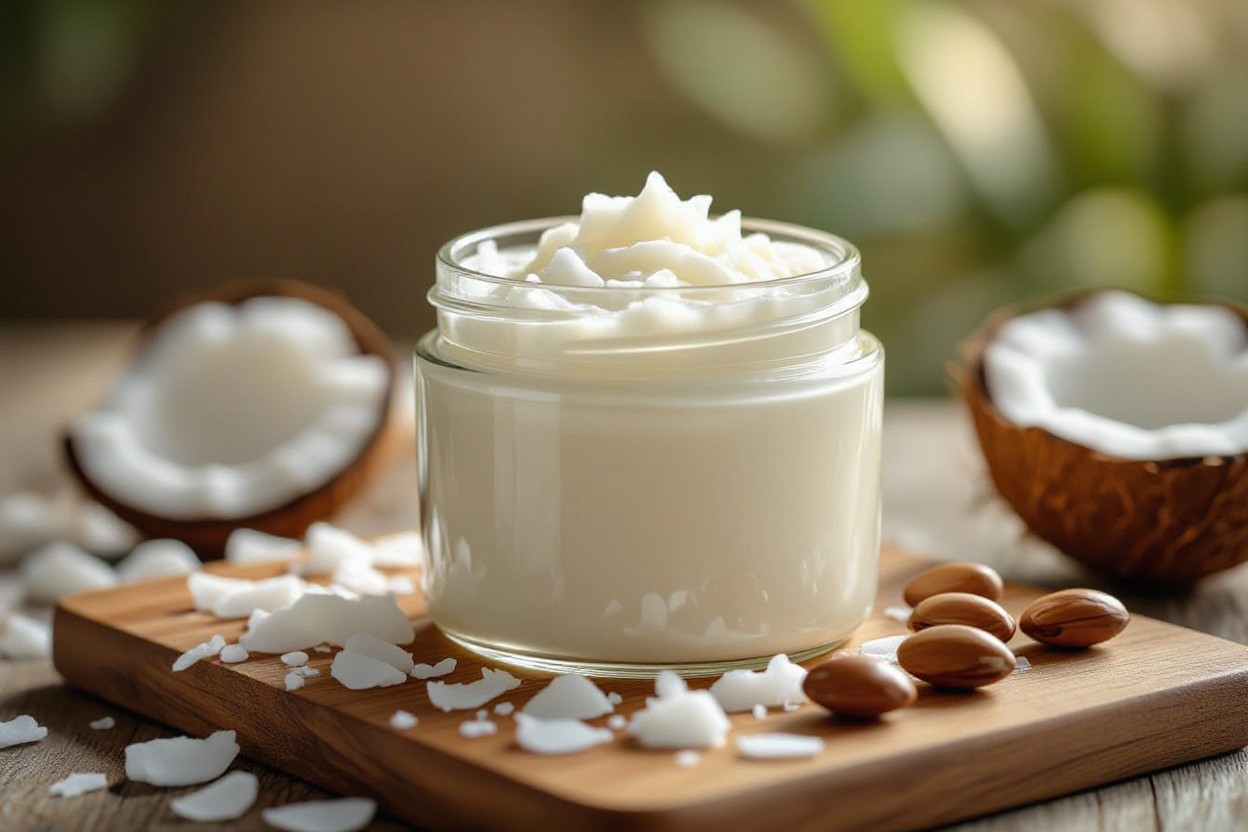
Types of Coconut Oil and Argan Oil
| Virgin Coconut Oil | Cold-pressed, high lauric acid (~45–54%), antimicrobial, solid below ~24°C, strong coconut aroma, best for skin/hair masks |
| Refined Coconut Oil | Deodorized/bleached, neutral scent, higher smoke point (~204°C), longer shelf life, used in formulations where fragrance is unwanted |
| Fractionated Coconut Oil | Liquid at room temperature, mainly MCTs, lightweight carrier oil for serums and makeup removal blends |
| Pure Argan Oil | Cold-pressed from Moroccan kernels, rich in oleic (≈43–49%) and linoleic (≈29–36%) acids, high vitamin E, deeply hydrating without heavy residue |
| Refined/Cosmetic Argan | Filtered or lightly refined for fragrance/color consistency, used in commercial skincare where stability and clarity matter |
- You can choose virgin coconut for antimicrobial benefits and a fuller nutrient profile when you want maximum hydration.
- Many formulators pick refined coconut if you need a neutral-scent base that blends well into creams and removers.
- Any blend of coconut and argan balances lauric-driven antimicrobial action with argan’s vitamin E and fatty-acid nourishment for both skin and hair.
Virgin Coconut Oil
You’ll find virgin coconut oil cold-pressed and unrefined, with lauric acid making up roughly 45–54% of its fatty acids; this gives it antimicrobial benefits and deep occlusive hydration, so a 15–30 minute hair mask twice weekly can noticeably reduce dryness and enhance shine.
Refined Coconut Oil
You can use refined coconut oil when you need a neutral-smelling base—it’s bleached and deodorized, has a higher smoke point around 204°C (400°F), and offers moisturizing occlusion without coconut aroma, making it ideal for fragrance-sensitive applications and commercial cleansers.
Because refinement removes some polyphenols and volatile compounds, you’ll trade a bit of antioxidant content for stability: refined oil tends to have a longer shelf life and consistent color, and formulators often prefer it in leave-on products and makeup removers where scent or color would interfere with other actives.
Pure Argan Oil
You should use pure argan oil for lightweight hydration; cold-pressed cosmetic-grade argan delivers high levels of oleic and linoleic acids plus vitamin E, so just 2–3 drops applied to damp skin or worked through mid-lengths of hair can soften, reduce frizz, and add nourishment without heavy greasiness.
Source matters: authentic Moroccan cold-pressed argan retains antioxidant tocopherols and sterols, and cosmetic-grade bottles often list free-fatty-acid content and peroxide values—look for certificates or GC-MS data if you need clinical-level consistency; blending 1 part argan with 2 parts coconut oil often yields a balanced texture for masks and daily serums.
Types of Coconut Oil and Argan Oil
- You’ll find oils vary by processing, scent, and nutrient retention.
- You can choose oils for skin, hair, or high-heat cooking based on smoke point and aroma.
- You should consider fatty-acid profile: lauric-rich coconut vs. oleic/linoleic-rich argan.
| Virgin Coconut Oil | Unrefined, strong coconut aroma, high lauric acid (~47–52%), good for skin/hair and antimicrobial use. |
| Refined Coconut Oil | Neutral scent, higher smoke point (~204°C/400°F), milder on sensitive skin, better for high-heat cooking. |
| Fractionated Coconut Oil | Liquid at room temp, mostly MCTs, lightweight carrier oil for blends and serums. |
| Pure Argan Oil | Cold-pressed, high in vitamin E and antioxidants, about 45–55% oleic and 30–40% linoleic acids, deeply moisturizing. |
| Blends (Coconut + Argan) | Formulated ratios (e.g., 70/30 or 50/50) balance hydration, weight, and scent for tailored cosmetic uses. |
Virgin Coconut Oil
You get unrefined oil pressed from fresh coconut meat, with a pronounced scent and about 47–52% lauric acid that gives antimicrobial benefits; you can use it as an intensive hair mask or skin moisturizer, and it melts around 24°C so you’ll warm it in your hands for easier application.
Refined Coconut Oil
You’ll notice refined coconut oil is deodorized and filtered, offering a neutral scent and a higher smoke point near 204°C (400°F); you can prefer it for makeup removal if you want less coconut aroma and for cooking at higher temperatures.
In practice, refined oil undergoes bleaching and deodorizing which reduces some antioxidants and volatile compounds, so while it’s gentler-smelling and stable for heat, you’ll sacrifice some of the antimicrobial potency found in virgin oil; test it on your skin if you’re sensitive and look for minimally processed refined labels to retain as much benefit as possible.
Pure Argan Oil
You’ll use pure, cold-pressed argan oil when you want high vitamin E and antioxidant content; with roughly 45–55% oleic and 30–40% linoleic acids, it absorbs fast, reduces frizz, and supports skin barrier repair without feeling greasy.
As a targeted treatment, pure argan oil often shows measurable improvements in hair shine and skin elasticity in 4–8 weeks when applied consistently; you can apply 2–3 drops to damp hair ends or mix 1–2 drops into your moisturizer to boost antioxidant protection and hydration.
Blends of Coconut and Argan Oil
You’ll find blended formulas combine coconut’s antimicrobial lauric profile with argan’s vitamin E and fatty-acid balance, often in ratios like 70/30 for deep conditioning or 30/70 for a lighter daily facial oil; you can pick a blend based on desired weight and scent.
Manufacturers often tailor blends: a 70% virgin coconut/30% argan mix gives intensive moisturization for dry or coiled hair, whereas a 30/70 mix yields a non-greasy finish for facial use; Any blends you choose should be patch-tested on your skin before full use.
Benefits of Combining Coconut Oil and Argan Oil
Combining coconut and argan oils gives you fast hydration plus long-term nourishment: coconut (about 45–50% lauric acid) locks moisture and can reduce microbial load, while argan (oleic ~45–50%, linoleic ~30–35%) supplies vitamin E and antioxidants for skin repair — see Coconut oil has several beneficial effects on the skin: 1. Softening and barrier support for user anecdotes and tips.
Skin Moisturization
You’ll notice rapid softness when you layer the oils: coconut seals the barrier and reduces transepidermal water loss, while argan’s fatty acids and vitamin E (tocopherols) improve elasticity; apply a pea-sized amount to damp skin after showering or use a 1:1 mix as a nightly face and body treatment to see visible hydration within days.
Hair Nourishment
You can cut breakage and boost shine by using the blend as a pre-wash treatment: coconut’s lauric acid penetrates the shaft and reduces protein loss, and argan adds surface lipids for slip and manageability — try 1–2 teaspoons on mid-lengths and ends for 20–60 minutes before shampooing, once or twice weekly.
For deeper repair, use the oils as an overnight mask two to three times a month; coconut’s low molecular weight helps it enter cortex regions, while argan’s unsaturated fatty acids (oleic, linoleic) and antioxidants fortify cuticle layers, improving tensile strength and reducing split ends over 4–8 weeks of consistent use.
Antimicrobial Properties
You can exploit coconut oil’s antimicrobial profile (high lauric acid content converts to monolaurin) to help manage surface bacteria and fungi on skin and scalp; incorporate the blend into your makeup-removal routine or use as a gentle spot treatment, observing for irritation and limiting application to affected areas.
In vitro studies show coconut-derived monolaurin activity against organisms like Staphylococcus aureus and Candida species, so pairing it with argan’s anti-inflammatory tocopherols can reduce redness and flaking; always patch-test and consult a clinician for persistent infections or compromised skin barriers.
Benefits of Coconut Oil with Argan Oil
You gain a dual-action blend: coconut oil’s medium-chain fatty acids (lauric acid ~47–52%) deliver antimicrobial action and occlusive moisture, while argan oil’s high unsaturated fatty acid profile and vitamin E provide hydration, nourishment, and antioxidant support; together they strengthen hair cuticles, soften skin, and reduce transepidermal water loss when used routinely (pea-sized amounts for face, 1–2 teaspoons for hair ends).
Moisturizing Properties
You’ll notice immediate softness because coconut oil forms a light barrier that seals water into the skin and hair; argan oil, composed largely of oleic and linoleic acids, penetrates to replenish lipids and vitamin E boosts barrier repair—apply to damp skin or towel-dried hair for best absorption and measurable improvement in smoothness within 1–2 weeks of regular use.
Antimicrobial Benefits
You benefit from lauric acid’s documented in vitro activity—coconut oil contains ~47–52% lauric acid, which shows inhibitory effects against Staphylococcus aureus, Candida albicans and Cutibacterium acnes; argan oil adds phenolic compounds that provide mild antimicrobial and antioxidant support, making the blend useful for reducing surface microbes on skin when applied appropriately.
In practical terms, you can use a thin layer on minor dry patches or blemish-prone areas: lab studies show lauric acid reduces growth of common skin microbes in vitro, and combining it with argan’s anti-inflammatory tocopherols may minimize irritation—avoid heavy application on acne-prone faces without patch testing and stop use if irritation occurs.
Makeup Removal Effectiveness
You’ll find the blend excels at dissolving oil-based makeup, including waterproof mascara; coconut oil breaks down stubborn pigments while argan oil leaves a non-greasy, hydrated finish—massage a teaspoon onto dry skin for 30–60 seconds, emulsify with warm water, then rinse or follow with a gentle cleanser to remove residue and maintain skin balance.
For heavier eye makeup, you can use a cotton pad soaked with the oil blend and hold it on closed lashes for 10–20 seconds to loosen waterproof formulas; clinical comparisons of oil cleansers show strong removal efficacy with lower irritation than some surfactant-heavy removers, and argan’s tocopherols help soothe the delicate eye area after cleansing.
Benefits of Coconut Oil with Argan Oil
Moisturizing Skin and Hair
Because coconut oil penetrates the hair shaft and argan oil sits on the surface, you get both deep and surface hydration; coconut’s lauric acid (~45–50% of its fatty acids) reduces protein loss when used as a pre-wash treatment, while argan’s fatty acids lock in moisture, leaving hair less brittle and skin softer after regular use.
Antimicrobial Properties
Lauric acid in coconut oil converts to monolaurin, which has demonstrated in‑vitro activity against bacteria and fungi, so you can expect reduced surface microbial counts when used appropriately; argan oil’s polyphenols add mild antimicrobial and anti‑inflammatory support to that effect.
Mechanistically, these fatty acids disrupt microbial lipid membranes and interfere with pathogen replication; in practice, topical application to non‑open skin or scalp areas can lower common surface flora such as Staphylococcus species and reduce yeast overgrowth tendencies, especially when combined with good hygiene and targeted treatment.
Effective Makeup Remover
Oil dissolves oil, so this blend removes long‑wear foundations, waterproof mascara, and sunscreen efficiently: warm a few drops in your palms, massage over closed eyes and face, then wipe with a soft cloth—most users find one gentle wipe removes stubborn pigments without harsh rubbing.
For best results, follow an oil cleanse with a mild foaming cleanser (double cleanse) to emulsify residue; clinicians and beauty pros often recommend a two‑step routine for oily skin types to prevent buildup while maintaining the oil’s dissolving power on pigments and silicone‑based products.
Hydration and Nourishment
Argan oil’s high tocopherol content and unsaturated fatty acids (oleic ~43–49%, linoleic ~29–36%) supply antioxidants and building blocks for barrier repair, so you get measurable improvements in hydration and reduced transepidermal water loss when you apply it consistently.
Use 2–4 drops on your face after cleansing or a dime‑sized amount through mid‑lengths of damp hair 1–3 times weekly to see increased softness and improved elasticity; the combination supports long‑term barrier function and delivers vitamins directly where your skin and hair need them.
Tips for Using Coconut Oil with Argan Oil
Adjust blends to your needs: keep coconut low on acne-prone facial skin (10–25% of the mix) and use 1:1 for hair masks. Test a dime‑sized amount behind your ear for 24 hours to check sensitivity, and limit scalp treatments to 5–10 minutes of massage before rinsing to avoid buildup. Apply as a warm, emulsified makeup remover and follow with a gentle cleanser. Any storage tip: keep the blend in a cool, dark place and shake or warm briefly before use.
- Patch test 24 hours before first full use.
- Hair mask: 1:1 coconut:argan, leave 20–45 minutes or overnight for deep conditioning.
- Scalp massage: 1–2 tsp, 5–10 minutes, rinse with sulfate‑free shampoo.
- Makeup removal: warm 1 tsp, emulsify with water, wipe with a soft cloth.
- Facial hydration: start with 2–3 drops and increase as needed; oily skin: 2–3×/week.
Application Techniques
Warm a small amount between your palms to liquefy the oils and improve absorption; for makeup removal emulsify with water and wipe gently, then double‑cleanse. For hair, distribute from mid‑lengths to ends using 1–2 tablespoons for shoulder‑length hair, comb through, and wrap in a warm towel for 30–45 minutes or sleep in a silk cap for an overnight treatment. When treating the scalp, use 1 teaspoon to 1 tablespoon and massage 5–10 minutes to boost circulation and antimicrobial action.
Dosage Recommendations
Face: 1–3 drops after serum or as a standalone night moisturizer, 2–3×/week for oily skin and daily for dry skin. Hair: 1–2 tbsp for medium length, 2–3 tbsp for long hair; use as a weekly deep treatment or biweekly if hair is very dry. Scalp: 1–2 tsp per application, limit to once weekly for oily scalps.
Adjust by hair length and skin response: if pores clog, reduce coconut proportion to under 10–25% of the blend and favor argan-only topicals. Track frequency for four weeks to spot improvements or irritation. For targeted repair, increase hair mask duration to 60–90 minutes or overnight twice monthly. Always patch test new ratios and stop use if you see persistent redness, itching, or breakouts.
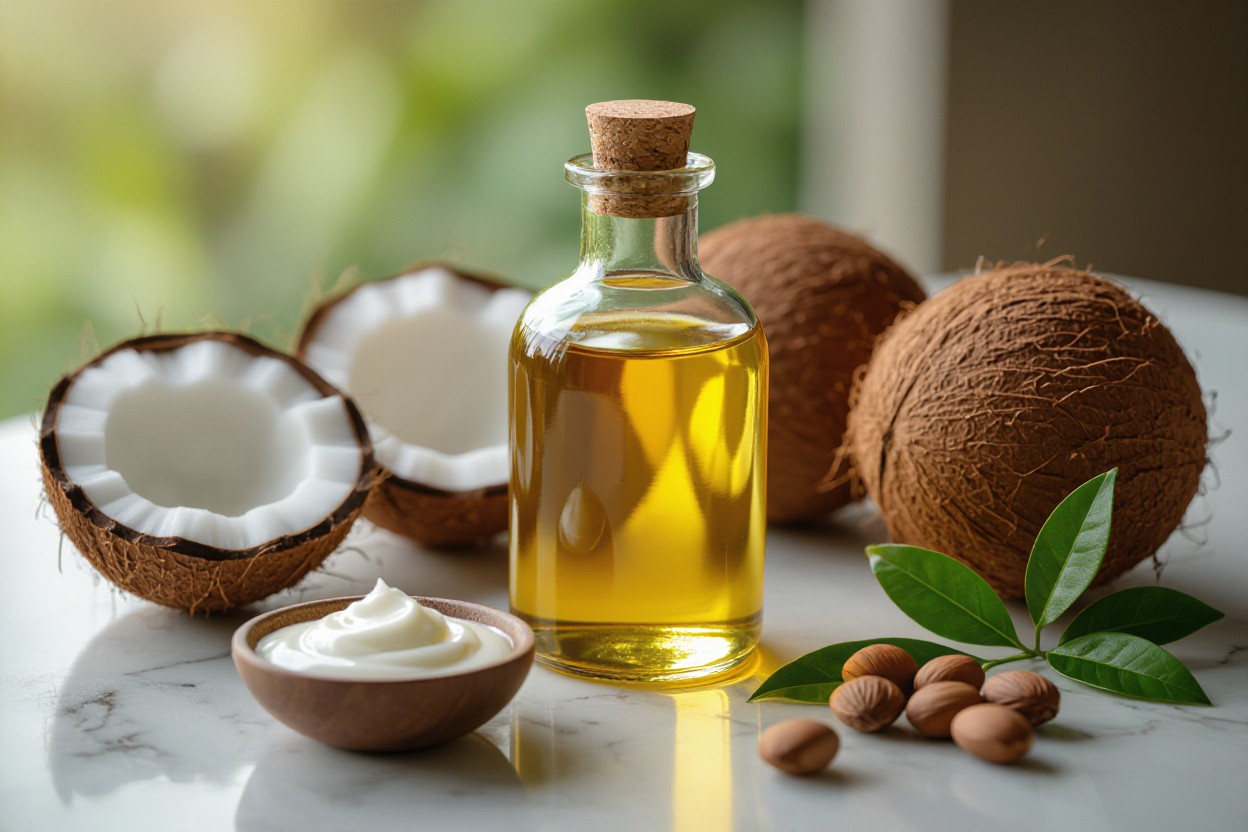
Tips for Using Coconut Oil with Argan Oil
Mix at 1:1 for balanced hydration or try 2 parts argan to 1 part coconut for a lighter finish; apply a pea- to dime-sized amount on the face and 1–2 teaspoons for short hair (increase for longer lengths). Use as a night moisturizer 2–3 times weekly or a pre-wash hair mask left 30–60 minutes before shampooing. Patch test for 24 hours on the inner forearm and Any time you adjust ratios note how your skin or scalp responds within a day.
- You should test a 24-hour patch on the inner forearm before full use.
- You can use 2:1 argan:coconut for fine hair and 1:1 or coconut-forward for coarse hair.
- You may warm a pea-sized amount to remove makeup, wiping with a microfiber cloth.
- You should avoid heavy application on oily or acne-prone skin and focus on dry patches.
For Skin
Apply a 1:1 blend as an evening occlusive 2–3 times per week; for oily skin, use 2 drops argan per pea-sized coconut amount. Use about a quarter-teaspoon for the face, avoid the eyelids, and perform a 24-hour patch test. Given coconut’s lauric acid (~47–52%) antimicrobial activity and argan’s vitamin E and fatty acids, you can reduce flakiness and improve barrier hydration with targeted spot treatments on elbows, heels, or chapped lips.
For Hair
Use the blend as a pre-wash mask to reduce protein loss—apply 1–2 teaspoons for short hair, 1 tablespoon for shoulder-length, and leave 30–60 minutes before shampooing; research supports coconut oil’s ability to lower hair protein loss when used pre-wash. If your hair is fine, favor argan (2:1 argan:coconut) to avoid weighing it down, while curly or coarse hair tolerates a 1:1 or coconut-forward mix for deeper penetration into the shaft.
For deep conditioning, apply 2 tablespoons for long hair, concentrate on mid-lengths and ends, and cover with a shower cap—heat for 20–30 minutes or leave overnight no more than once weekly. Emulsify well with warm water and shampoo twice to remove residue; if you notice buildup or limpness, reduce frequency to every 10–14 days and focus product on the ends rather than the scalp. Any adjustments should be logged so you track what ratio and timing deliver the best results.
Tips for Using Coconut Oil with Argan Oil
Mix a 1:1 ratio for balanced hydration, increase argan if you have oily skin, or raise coconut for deeper occlusion on dry ends; warm a pea-sized amount between palms for facial use. For hair, try 1–2 tablespoons as a pre-shampoo mask or 2–3 drops as a leave-in finishing oil. Recognizing your skin and hair reactions within two weeks lets you fine-tune frequency and ratios.
- Patch-test a small amount on your inner forearm for 24 hours
- Store blends in a cool, dark place in a glass container
- Melt solid coconut oil in your hands or a warm bowl before applying
Application Methods
For makeup removal, apply a dime-sized amount to dry skin and wipe with a cotton pad, then cleanse; for face hydration, use a pea-sized amount and massage 1–2 minutes; for hair, apply 1–2 tablespoons mid-length to ends as a 20–60 minute pre-shampoo mask or 2–3 drops as a post-dry styling serum; for scalp health, massage 5–10 minutes and leave 30–60 minutes before washing.
Frequency of Use
If your hair is damaged, use a weekly deep-mask (1–2× per week); for general scalp care, 1×–2× weekly works well; as a nightly facial oil for dry skin, you can apply 3–4× per week or nightly if tolerated; fine or acne-prone skin should limit use to 1–2× weekly and spot-treat oily areas.
Adjust based on measurable changes: if you see reduced frizz and increased shine after two sessions, maintain that cadence; if pores feel congested or you notice breakouts within a week, cut back to less than twice weekly and favor higher-argan ratios (70% argan/30% coconut) or switch to lighter carriers like jojoba for facial use.
Combining with Other Ingredients
Pair 1 tbsp of your oil blend with 1 tsp vitamin E (one capsule) for antioxidant support, add 2–3 drops of lavender or rosemary necessary oil per tablespoon for scent and scalp stimulation, mix with 1 tbsp honey for a hydrating mask, or stir into ¼ cup yogurt for protein-rich hair treatments; avoid direct water mixes without an emulsifier.
When formulating DIY masks, follow clear ratios: ¼ cup base (oil blend) + 1 tbsp honey + 2 tbsp yogurt for damaged hair, or 1 tsp oil blend + 1 tsp aloe vera gel for a lighter facial boost—always dilute necessary oils below 1% (about 6 drops per 1 tbsp carrier) and patch-test each new combination.
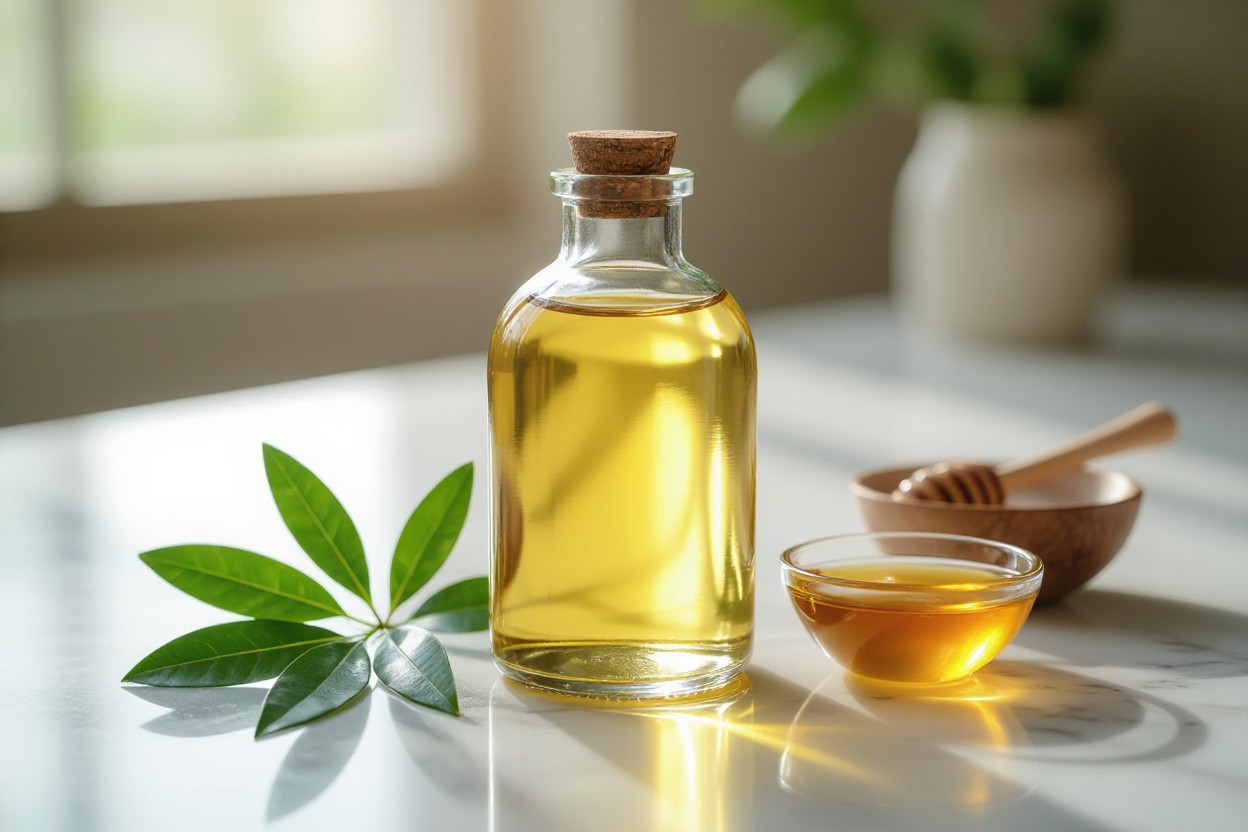
Step-by-Step Guide to Make Your Blend
Quick Reference
| Batch Example (100 ml) | 70 ml coconut oil + 30 ml argan oil |
| Ratio Options | 2:1 coconut:argan for richer occlusion; 3:1 for lighter feel |
| Tools | Digital scale or measuring spoons, small saucepan or bowl for warm water bath, amber glass jar, funnel, sanitized spoon |
| Storage & Shelf Life | Amber jar, cool dark place ≤25°C, use within 6–12 months; discard if smell or color changes |
Ingredients Needed
You’ll need two core oils: coconut oil (virgin or fractionated) and cold‑pressed argan oil; for a 100 ml batch use 70 ml coconut and 30 ml argan to balance hydration and lightness. Optional extras include 5–10 drops of vitamin E as an antioxidant or 0.5–1% crucial oil (e.g., lavender) for fragrance. Choose high‑quality, food‑grade or cosmetic‑grade oils to preserve antimicrobial benefits from coconut’s lauric acid (~47–52%) and argan’s nourishing fatty acids.
Mixing and Storage
Gently melt solid coconut oil in a warm water bath (keep under 40–45°C), add measured argan oil, stir until homogenous, then pour into a sterilized amber jar and label with the date; store in a cool, dark spot and use within 6–12 months to avoid rancidity.
To mix precisely, weigh oils on a digital scale—for 100 g total that’s 70 g coconut and 30 g argan—heat coconut only until liquid, then combine off heat to preserve argan’s nutrients; if you want a whipped texture, cool the blend until edges firm and whip 2–3 minutes with a hand mixer. Sanitize containers and hands, keep crucial oils ≤1% (about 6–10 drops per 100 ml) for safety, and test a small patch for sensitivity. Watch for off odors or discoloration as signs to discard.
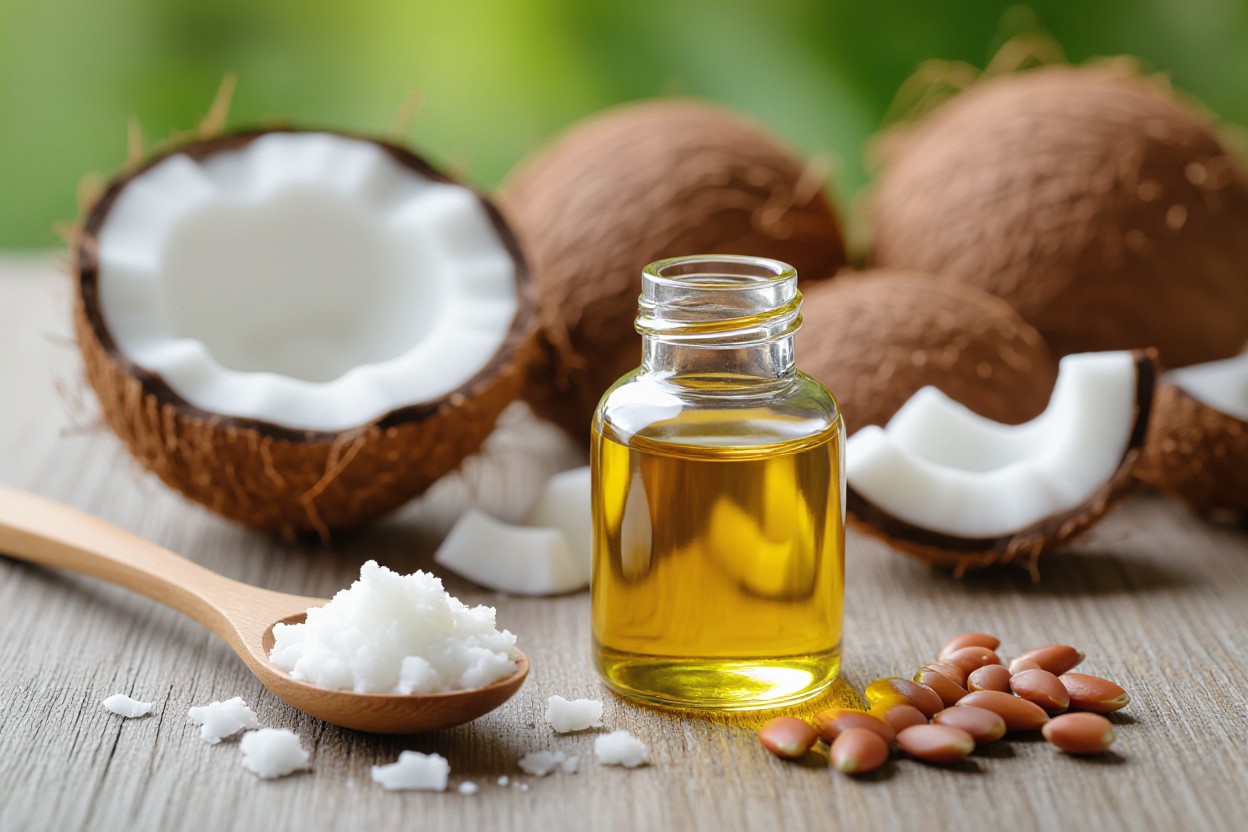
Step-by-Step Guide to Using Coconut Oil with Argan Oil
Follow these practical steps to blend and apply coconut and argan oil for skin and hair. Start with a 1:1 or 2:1 (coconut:argan) ratio depending on thickness, perform a 24-hour patch test, warm the mixture before applying, and adapt leave-in times: 5–15 minutes for skin, 10–60 minutes for hair, or overnight for deep conditioning.
Quick Steps
| Step | Details |
|---|---|
| Mix | 1:1 for balanced feel, 2:1 coconut for thicker treatment |
| Patch test | Apply small amount to inner forearm; wait 24 hours |
| Skin application | Warm oil, apply to damp skin, 5–15 minute leave or massage until absorbed |
| Hair application | Use 1–2 tbsp for shoulder-length hair, warm, leave 10–60 min or overnight; shampoo twice |
| Removal | Wipe makeup with cotton pad then cleanse; shampoo twice for hair |
Application Methods for Skin
For makeup removal, apply 1–2 drops to a cotton pad or 1 teaspoon for full-face, massage gently to dissolve waterproof mascara and eyeliner, then wipe and follow with a mild cleanser. For hydration, press 1–2 drops into damp skin or use 1 tablespoon for body; coconut’s lauric acid offers antimicrobial action while argan supplies vitamin E and vital fatty acids.
Application Methods for Hair
Use as a pre-shampoo mask: warm 1–2 tablespoons for shoulder-length hair, apply from mid-lengths to ends, and massage into the scalp only if it’s dry. Cover with a shower cap, leave 10–60 minutes or overnight for deep repair, then shampoo twice. For lightweight finishing, smooth 1–2 drops on damp ends to reduce frizz and add shine.
Mix 1 tablespoon coconut oil with 1 tablespoon argan for medium hair; warm 5–10 seconds in your hands or briefly in the microwave, detangle, and work through sections with a wide-tooth comb. Apply heat with a towel or low dryer for 20–30 minutes to boost penetration, rinse and shampoo thoroughly. Use 1–2 times weekly for dry hair, every 2–3 weeks for fine hair, and avoid roots to prevent buildup.
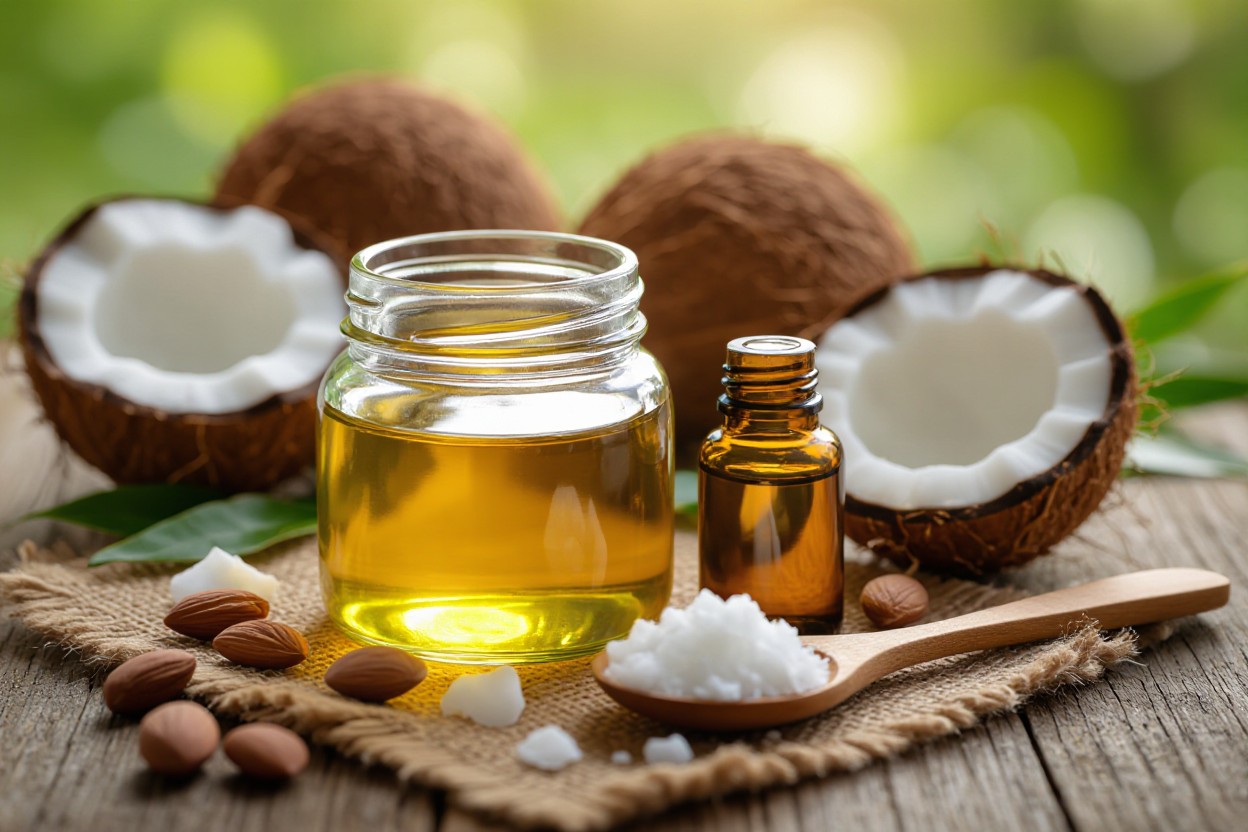
Factors to Consider
Balance potency, texture and pore-clogging risk when integrating coconut-argan blends into your routine; coconut offers antimicrobial action and occlusion while argan supplies vitamin E and linoleic-rich hydration. Check product purity, ratio (for example, 70% argan vs 30% coconut feels lighter), and any added fragrances or preservatives that provoke irritation. Assume that adjusting the blend—more argan for face, more coconut for body—helps you target hydration without triggering breakouts.
- Comedogenic ratings (coconut ~4, argan 0–1)
- Oil ratio (argan-heavy vs coconut-heavy)
- Refined vs unrefined processing
- Added ingredients: fragrance, preservatives
- Intended use: face, body, hair, makeup removal
- Pore type and frequency of application
Skin Type Compatibility
If you have oily or acne-prone skin, prioritize argan-rich formulas because argan’s linoleic acid content helps balance sebum and its comedogenic rating is low; conversely, dry or very dry skin benefits from higher coconut ratios for stronger occlusion and moisture retention. For combination skin, use argan on the T-zone and coconut on drier areas, and limit facial use of coconut oil to nights or body-only applications to reduce congestion.
Allergies and Sensitivities
Perform a patch test by applying a pea-sized amount behind your ear or on the inner forearm and observe for 24–48 hours; watch for redness, itching, swelling, or blistering, and discontinue immediately if any occur. If you have a documented tree-nut allergy, consult your allergist before using argan oil topically, since cross-reactivity is possible.
Although coconut allergy is uncommon (<0.1% reported), tree-nut allergies affect about 1% of the population in some regions, so exercise caution: choose refined oils if you react to proteins in cold‑pressed varieties, read labels for additives (fragrance, preservatives like BHT), and get formal testing if you’ve had systemic or severe reactions to topical or ingested nut products.

Step-by-Step Guide to Make Your Own Blend
| Ingredients Needed | 2 tbsp virgin coconut oil, 1 tbsp argan oil (adjustable ratio), 5–10 drops necessary oil (lavender or tea tree optional), 30–50 ml amber glass bottle, small funnel, measuring spoons or scale, double boiler or small saucepan, thermometer. |
| Preparation Steps | Melt coconut oil gently to ~40°C (104°F), remove from heat, stir in argan oil and necessary oil, pour into bottle while fluid, label with date, cool; use 2:1 for hair treatments or 3:1 for facial use, perform a patch test before regular use. |
Ingredients Needed
You’ll gather 2 tbsp virgin coconut oil and 1 tbsp argan oil as a baseline, plus 5–10 drops of an optional necessary oil (lavender for calming, tea tree for added antimicrobial action). You should also have a 30–50 ml amber glass bottle, funnel, measuring spoons or a small scale, and a double boiler or small saucepan to control heat precisely.
Preparation Steps
Start by melting the coconut oil in a double boiler to about 40°C (104°F), then remove from heat and stir in argan oil and any necessary oils until homogenous; pour the blend into a sterilized amber bottle while still fluid, label with the date, and let cool. For dry hair use a 2:1 coconut:argan ratio, for daily facial hydration try 3:1, and always perform a patch test.
If coconut oil is solid at room temperature, warm it until fully liquid but avoid exceeding 50°C to protect vitamin E and fatty acids; use sterile utensils to reduce contamination and pour while warm to minimize separation. For a lighter leave-in serum, substitute fractionated coconut oil and try a 1:1 ratio with argan; store the finished blend in a cool, dark place and expect a 6–12 month shelf life unless you detect a rancid odor.
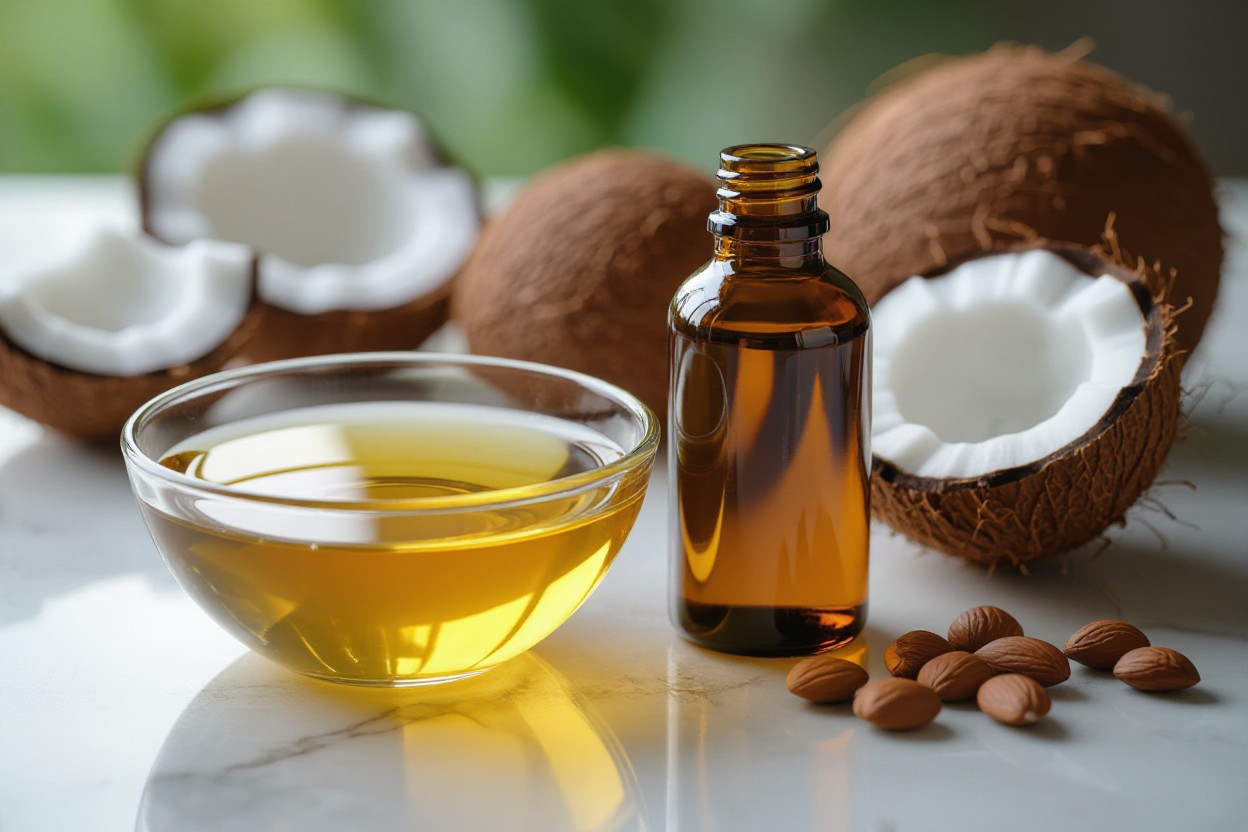
Factors to Consider
Balance potency, texture and pore-clogging risk when integrating coconut-argan blends: coconut oil has a comedogenic rating of 4 and solidifies below ~24°C, while argan oil is lightweight and rich in vitamin E and linoleic acid.
- Potency: lauric acid in coconut provides antimicrobial action—adjust ratio (example 2:1 coconut to argan from the recipe).
- Texture: coconut can feel heavy; argan lightens the finish and adds slip for hair.
- Recommendation: test a patch and consider a pure option like Cococare 100% Natural Moroccan Argan Oil.
This lets you dial hydration, minimize breakouts, and match texture to your routine.
Skin/Hair Type Compatibility
If you have oily or acne-prone skin keep coconut low (e.g., 10–30% of the blend) and favor argan to reduce pore risk; for dry, coarse or high-porosity hair a 2:1 coconut-to-argan mix seals moisture and improves manageability; if your hair is fine or low-porosity use mostly argan or apply coconut only to mid-lengths and ends to avoid weighing strands.
Quality of Oils
Choose cold-pressed, unrefined (virgin) coconut and pure cold-pressed argan, avoid hexane-extracted or fragranced products, and prioritize dark-glass packaging with a clear ingredient list; typical shelf life is about 24 months for coconut and 12–18 months for argan, so store cool and away from light.
Look for USDA Organic or COSMOS certification and, when possible, a COA or GC‑MS report to confirm purity; authentic argan is viscous with a faint nutty aroma and pure coconut smells fresh, not rancid. Expect genuine argan prices around $10–30 for 30 ml—very low prices often indicate dilution—so favor brands or cooperatives that disclose sourcing and testing and always patch-test new batches on a small area of skin.
Pros and Cons
| Pros | Cons |
|---|---|
| Deep moisturization for skin and hair | Comedogenic for oily/acne-prone skin (coconut oil rated ~4) |
| Antimicrobial action from lauric acid in coconut oil | Can leave an oily residue if overapplied |
| Effective makeup removal—breaks down sebum-based products | May irritate sensitive eyes if not fully emulsified |
| Argan oil adds vitamin E and imperative fatty acids for nourishment | Higher cost than single-oil options |
| Improves hair shine and reduces frizz | Can weigh down fine hair or cause buildup without clarifying |
| Natural ingredients with long shelf life when stored properly | Risk of allergic reaction (tree-nut sensitivity to argan) |
Advantages of Use
You get fast, measurable benefits: coconut oil’s lauric-rich profile (roughly 45% lauric acid) brings antimicrobial support while argan contributes vitamin E and unsaturated fatty acids for hydration. Many users report improved hair shine within 1–3 applications and softer skin after nightly use. You can use the blend as a 1–2 minute makeup remover, a leave-on hair treatment, or a body moisturizer, making it a versatile 2-in-1 product that replaces multiple single-use items.
Potential Drawbacks
You should expect trade-offs: coconut oil’s high comedogenicity (commonly rated ~4) can clog pores, especially if you’re acne-prone, and argan increases cost. Some people notice greasiness or product buildup on fine hair after repeated use, and a small percentage may react to tree-nut proteins in argan oil.
Mitigate these issues by patch-testing for 48 hours, limiting facial use to drier areas or nighttime only, and using a clarifying shampoo 1–2 times weekly if you apply to hair frequently. You can also blend with lighter carriers (jojoba or grapeseed) to lower pore-clogging potential, and fully emulsify the oil with a cleanser when removing eye makeup to avoid irritation.
Factors to Consider When Choosing Oils
- Pore‑clogging risk: coconut oil has a comedogenic rating around 4, while argan typically rates 0–1, so balance ratios if you’re acne‑prone.
- Hair porosity: low‑porosity hair benefits from lighter argan, high‑porosity hair can accept richer coconut blends for sealing and moisture retention.
- Scent and sensitivities: test fragranced formulas for 24–48 hours to catch irritation; pure, cold‑pressed oils reduce additive risk.
- Function: coconut gives antimicrobial lauric acid (≈45–53%) and makeup‑removal power; argan supplies oleic/linoleic acids and vitamin E for hydration and repair.
- Formulation ratios and testing: aim for 10–30% coconut in facial blends to limit clogging and higher concentrations for scalp or makeup removal.
- Perceiving how an oil feels on your skin and hair, do a 48‑hour patch and small‑scale trial before full use.
Skin Type Compatibility
If you have oily or acne‑prone skin, lean toward argan or low‑coconut blends because argan’s light, non‑comedogenic profile (0–1) reduces breakouts; drier skin benefits from coconut’s occlusive moisture and lauric acid’s antimicrobial action—use 10–30% coconut in face oils, and consider heavier coconut for body or dry hair ends to lock in hydration without overloading facial pores.
Quality of Oil
Choose cold‑pressed, virgin or unrefined oils: virgin coconut retains lauric acid content and antimicrobial potency, while unrefined argan preserves tocopherols and crucial fatty acids; check for “100% pure,” batch numbers, organic certification, and third‑party GC‑MS or COA testing to verify purity and absence of hexane or adulterants.
More quality checks: examine color and aroma—fresh virgin coconut oil has a subtle coconut scent and a clear to slightly opaque appearance when liquid; argan should smell nutty, not rancid. Review peroxide value or free fatty acid percentages if available (lower is better), and prefer suppliers listing harvest/press dates; adulteration is common—Moroccan‑sourced, fair‑trade argan with COA reduces risk, while fractionated coconut will be liquid and lack some lauric content.
Packaging and Storage
Store oils in dark glass (amber) bottles to limit light‑driven oxidation; you should keep them tightly sealed, away from heat and direct sunlight, ideally below 25°C, with typical shelf life of 12–24 months—use within 6–12 months after opening for peak potency, and refrigerate in hot climates to extend freshness.
For added protection, transfer larger bulk containers into smaller dark dropper bottles for daily use to minimize repeated air exposure; monitor smell and color—a bitter or sour odor signals rancidity. Avoid clear plastic packaging that can leach chemicals and accelerate degradation, and note that coconut oil will solidify below ~24°C, which is normal and not a spoilage sign.
Pros and Cons of Using Coconut Oil with Argan Oil
Pros and Cons Summary
You gain deep hydration plus antimicrobial benefits—coconut oil has about 47% lauric acid—while argan oil supplies vitamin E and roughly 80% unsaturated fatty acids for nourishment. Try a 1:1 blend as a 20–30 minute hair mask or quick makeup remover. Watch for pore-clogging if you’re acne-prone, and start with 2–4 drops on your face to avoid greasiness.
Pros and Cons
| Pros | Cons |
|---|---|
| Intense moisturization for skin and hair | Comedogenic rating ~4 — can clog pores for oily/acne-prone skin |
| Antimicrobial action from lauric acid (~47%) | May leave oily residue requiring a secondary cleanse |
| Adds shine and reduces frizz in curls and dry hair | Can weigh fine hair down if overused |
| Effective oil-based makeup remover for waterproof products | Not ideal as an everyday facial moisturizer for all skin types |
| Argan oil provides vitamin E and important fatty acids (~80% unsaturated) | Higher cost than single-oil options |
| Versatile: leave-in treatments, masks, cuticle care | Possible allergic or irritant reactions in sensitive users |
| Natural alternative to synthetic conditioners and removers | Inconsistent results without correct dilution or application |
FAQ
Q: What is Coconut Oil with Argan Oil?
A: A blended topical oil combining coconut oil and argan oil. Coconut oil supplies medium-chain fatty acids that form a light occlusive layer to seal in moisture and offers antimicrobial activity, while argan oil contributes high levels of fatty acids, vitamin E and antioxidants for added hydration, nourishment and skin barrier support.
Q: How does this blend moisturize skin and hair?
A: Coconut oil helps lock moisture into the skin and hair shafts by creating a protective layer, reducing transepidermal water loss. Argan oil penetrates more easily, delivering imperative fatty acids and vitamin E to improve softness, elasticity and manageability. Together they hydrate, smooth frizz and add a healthy-looking sheen.
Q: How should I use it as a makeup remover?
A: Apply a small amount to dry skin and gently massage over the face and eye area to dissolve oil-based makeup and sunscreen. Wipe away with a soft cloth or cotton pad, then follow with a mild cleanser or water to remove residue (double-cleanse if you wear heavy or waterproof makeup).
Q: Is this blend suitable for acne-prone or sensitive skin?
A: Argan oil is generally non-comedogenic and well tolerated, but coconut oil can be comedogenic for some people and may trigger breakouts. Do a patch test on a small area first, use sparingly on oily or acne-prone zones, and discontinue if irritation or increased acne occurs. For highly sensitive or rosacea-prone skin, consult a dermatologist before regular use.
Q: How do I use it on hair for hydration and nourishment?
A: Use as a pre-shampoo treatment by warming a small amount in your hands, applying from mid-lengths to ends, leaving on 15–60 minutes, then shampooing and conditioning. For light leave-in conditioning, apply a pea-sized amount to damp ends to tame frizz and add shine. For scalp care, massage a small amount into the scalp and rinse after 20–30 minutes if you have dry scalp; avoid heavy use if your scalp tends to be oily.
Q: What antimicrobial benefits does it provide?
A: Coconut oil contains lauric acid and related fatty acids with documented antimicrobial activity against certain bacteria and fungi in laboratory studies. Argan oil brings antioxidants that help maintain skin health. These properties can support skin hygiene, but the blend is not a replacement for medical treatments for infections.
Q: How should I store it and what precautions should I take?
A: Store in a cool, dry place away from direct sunlight and keep the lid tightly closed; shelf life is typically 12–24 months depending on formulation and storage. Patch-test before first use, avoid contact with eyes, and discontinue if allergic reaction or severe irritation occurs. Those with tree nut allergies should consult a healthcare provider before use due to argan’s origin.
Conclusion
To wrap up, you can rely on coconut oil with argan oil to deeply moisturize your skin and hair, provide antimicrobial protection, and remove makeup effectively, while argan delivers extra hydration and nourishment; learn more in Argan Oil vs. Coconut Oil: Which is Better for You | FRÉ Skincare.
Pros and Cons of Using Coconut Oil with Argan Oil
Pros vs Cons
| Pros | Cons |
|---|---|
| Deep moisturization for skin and hair | Can clog pores for acne-prone skin |
| Antimicrobial action (coconut oil contains ~50% lauric acid) | May cause irritation in sensitive users |
| Effective makeup remover for waterproof products | Leaves a heavy or greasy finish if overapplied |
| Argan adds vitamin E and necessary fatty acids for nourishment | Higher cost than single-oil options |
| Improves hair shine and reduces frizz | Risk of scalp buildup on very oily hair |
| Natural antioxidant properties | Quality varies; adulteration or rancidity possible |
Advantages
You get fast, measurable hydration: coconut oil penetrates the hair shaft while argan oil seals and adds vitamin E plus oleic and linoleic acids, improving shine and elasticity. Studies and user trials report reduced dryness and split ends when used 1–2 times weekly, and coconut’s lauric acid offers antimicrobial benefits that help with minor skin irritations and removing stubborn makeup without harsh surfactants.
Disadvantages
You may encounter pore-clogging—coconut oil has a comedogenic rating often cited as 4—so acne-prone skin can worsen. Also, some users report contact irritation or a greasy residue on hair if applied excessively, and blended products can be more expensive than single oils.
More specifically, you should patch-test before facial use and apply sparingly on the scalp: heavy application can lead to buildup and weigh fine hair down. Quality control matters too—look for cold-pressed, pure argan and virgin coconut oil, store them in a cool, dark place, and discard if odor or color changes to avoid irritation from rancid oil.
Summing up
The blend of coconut oil and argan oil gives you deep moisturization for your skin and hair, antimicrobial protection, and an effective makeup-removing option while argan oil provides extra hydration and nourishment, so you can simplify your routine and maintain healthy, supple skin and stronger, shinier hair.

